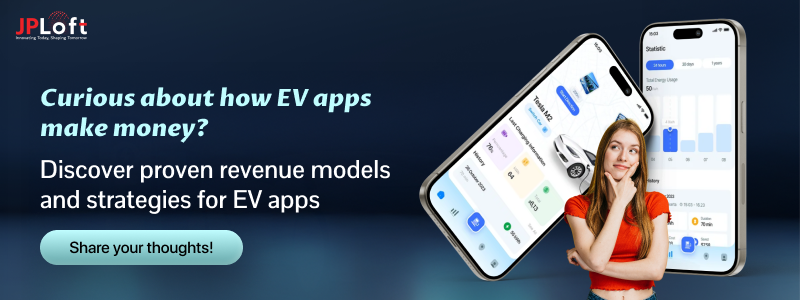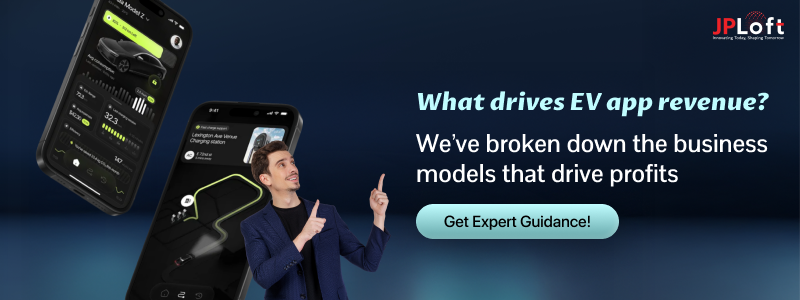Imagine driving down a quiet street, with fresher air and clearer skies, while an EV app seamlessly guides your every charge, route, and stop. Nowadays, smart EV apps are becoming a daily companion for drivers by finding nearby charging stations and offering seamless payment options.
But have you ever wondered how EV apps make money while providing these services? The answer lies in smart app monetization models. EV apps follow unique business models designed to generate consistent income.
So, in this blog, we’ll break down the different EV app monetization strategies, explore real-world examples, and show you why EV apps are not just transforming mobility but also creating new opportunities for businesses and startups.
Now, let’s dive deeper and uncover the models driving this green revolution.
Key Takeaways
EV app monetization ensures user convenience while generating sustainable profits for businesses.
The global EV app market is growing at a double-digit CAGR, creating massive revenue opportunities for entrepreneurs.
Understanding EV app development cost and ROI helps startups choose the best ways EV apps make money.
From subscriptions to data insights, diverse revenue streams for EV apps highlight the best monetization strategies.
Leading apps show that combining features with innovative business models is the smartest way to maximize EV app revenue.
JPLoft builds secure, scalable EV apps with real-time charging, AI, and loyalty features to help businesses maximize profitability
Market Statistics of Electric Vehicle Apps
The electric vehicle industry is growing rapidly, and technology is playing a key role in shaping this transformation.
Understanding the market trends behind these apps provides valuable insights for entrepreneurs, startups, and investors looking to tap into this booming sector.
-
A study by Allied Market Research shows that the global EV charging software market was valued at $1.1 billion in 2023 and is expected to skyrocket to $11.1 billion by 2032, growing at a remarkable CAGR of 28.9% between 2024 and 2032.
-
Global Market Insights reports that the EV charging market reached $2.8 billion in 2024 and is projected to expand at a CAGR of 23.1% from 2025 to 2034. This highlights the increasing reliance on apps to manage EV charging efficiently.
-
Interestingly, over 60% of EV users now interact with their vehicles via mobile apps, showcasing the tremendous business potential of EV app development.
-
The global electric vehicle market is also booming, with Statista projecting revenue of $784.2 billion by 2025, reflecting the strong demand for connected EV solutions.
-
Furthermore, data from Introspective Market Research indicates that this market was valued at $312.37 billion in 2024 and is expected to reach $1,119.58 billion by 2032, expanding at a CAGR of 17.3% between 2025 and 2032.
These figures clearly demonstrate that EV apps are not just a convenience for drivers, they are becoming a major revenue-generating opportunity in a rapidly evolving industry.
With more EVs hitting the roads each year, the demand for innovative, feature-rich apps is only set to grow.
EV App Monetization: What’s the Deal?
The rise of electric vehicles has created a massive opportunity for app developers. But a common question many people ask is: how EV apps make money when most of them appear free to download and use.
The answer lies in carefully designed monetization strategies for EV apps that ensure both user satisfaction and consistent profits for businesses. In fact, smart electric vehicle software development is what makes these apps not only functional but also profitable.
In simple terms, the business model of EV charging apps revolves around convenience. These apps connect EV drivers with nearby charging stations, provide real-time availability, enable seamless payments, and often offer rewards or loyalty programs.
Behind the scenes, this opens up multiple revenue streams for EV apps, such as:
-
Commission-based earnings: Apps charge a small fee per transaction from charging station operators.
-
Subscription models: Premium users get extra perks like faster booking, priority slots, or discounted charging rates.
-
Advertising & partnerships: Collaborations with EV manufacturers, retailers, or service providers boost app revenue.
-
Data-driven services: Apps can monetize user behavior insights by offering analytics to energy companies or businesses.
Ultimately, how EV charging apps generate revenue depends on balancing user convenience with sustainable business practices. A well-thought-out monetization plan is the key difference between an app that thrives and one that struggles to stay relevant in this fast-growing market.
Why Should You Care About EV App Monetization?
The EV industry is growing rapidly, and with it comes endless opportunities for businesses and startups. Here’s why understanding EV app monetization is so important:
A] Maximizing ROI on Development Costs
Building an EV app requires investment, and keeping track of cost and ROI is vital. A well-defined monetization strategy ensures that every dollar spent on development translates into long-term profits.
B] Sustainable Business Models
Many entrepreneurs wonder, “How do EV charging apps make money?” The answer lies in subscription plans, commission models, and partnerships. These sustainable models help apps remain profitable while continuing to serve EV users effectively.
C] Unlocking New Revenue Opportunities
With the rise of green mobility, startups are exploring how to make money with EV apps in innovative ways. From data monetization to premium features, the options are endless when you design the right business model.
D] Encouraging Innovation Through Unique App Ideas
The EV ecosystem is still evolving, which means there’s plenty of room for unique app ideas. Integrating eco-friendly rewards, driver communities, or green lifestyle tips can give your app a competitive edge while adding fresh monetization for EV industry opportunities.
In short, EV app monetization is not just about making profits, it’s about building sustainable solutions that grow with the EV industry. By choosing the right strategy, you can turn an innovative idea into a long-term business opportunity.
Different Ways Electric Vehicle Apps Make Money
The EV revolution is no longer a future dream, it’s happening right now. With millions of electric vehicles hitting the roads worldwide, the demand for smarter, more efficient apps is skyrocketing.
These apps are not just tools for drivers; they are powerful business assets for entrepreneurs and startups who want to tap into the growing clean mobility sector. But the real question is: how EV apps make money when most of them are free to download?
The answer lies in strategic EV app monetization. Let’s break down the different monetization strategies by exploring real-world examples, and see how they create sustainable profits.
1. Subscription-Based Models
One of the most common answers to “What is the business model of EV apps?” is subscriptions. The EV app subscription model allows companies to charge users a recurring fee for premium features.
For example, users may pay monthly or yearly to access perks such as priority booking of charging slots, discounts on charging rates, access to exclusive partner stations, and enhanced navigation with real-time traffic and weather alerts.
For drivers, these subscriptions add value by saving time and money, while for businesses, they create steady, predictable income. Many of the top apps like ChargePoint and Electrify America rely on this approach.
2. Commission & Transaction Fees
Another popular business model of EV charging apps revolves around commissions. Each time a driver uses the app to find and pay for a charging session, the app takes a small cut from the transaction.
For instance, if you develop a famous app like PlugShare, you could charge a commission from charging station operators every time a booking is made through your platform. This model is attractive because it doesn’t burden the driver with additional costs, station owners cover the fee as part of doing business.
3. Advertising & Brand Partnerships
How Electric Vehicle apps make money also extends into digital advertising and cross-promotions. EV apps have access to a highly targeted audience, eco-conscious drivers and early adopters of clean technology.
This makes them an excellent platform for EV manufacturers to promote new models, retailers to showcase green products, insurance companies to offer EV-specific plans, and even nearby cafes, restaurants, or malls to attract customers.
Strategic partnerships create mutual benefits; for example, an EV driver waiting at a charging station could receive a special coffee discount at a nearby café through the app.
4. Data Monetization & Analytics Services
One of the most powerful but often overlooked revenue streams for EV apps is data. EV apps collect valuable insights on driver habits, charging frequency, location preferences, and even energy consumption patterns.
Energy providers, city planners, and EV manufacturers are willing to pay for such analytics to improve infrastructure and services. By anonymizing and selling this data, apps can open a significant revenue stream.
Partnering with an experienced mobile app development company in Denver can help businesses implement secure and efficient data analytics solutions.
5. Pay-Per-Use Models
Some apps follow a simple pay-as-you-go strategy. Instead of subscriptions, drivers are charged small fees every time they use premium features like fast charging reservations, route optimization, or vehicle performance tracking.
This model is flexible and works well for casual EV drivers who don’t want to commit to recurring payments. It’s a practical solution when considering the biggest EV challenges, such as inconsistent charging availability and high infrastructure costs.
6. Value-Added Features of EV Apps
To stand out in a competitive market, developers are integrating advanced features of EV apps that open new monetization channels.
These include smart route planning powered by AI, loyalty rewards for eco-friendly driving, peer-to-peer charging options where users can rent out home chargers, and gamification that rewards drivers with points for reducing their carbon footprint.
The more innovative the features, the more appealing the app becomes to users and the easier it is to charge for premium access.
7. White-Label Solutions & B2B Models
Not all EV apps target end-users. Some businesses focus on creating electric vehicle solutions that can be licensed to fleet operators, charging networks, or even governments. White-label platforms allow companies to brand and use these apps as their own, creating another steady revenue stream for EV apps.
This model is particularly appealing for those looking to start a mobile EV charging business, as it reduces development time while offering scalable growth.
8. Cost Optimization & ROI in Development
While discussing monetization, one cannot ignore the cost to build an EV software. Depending on features, integrations, and design complexity, building a full-scale EV app may cost anywhere from $40,000 to $150,000 or more.
This is where having a clear revenue plan from day one becomes essential. Without understanding how electric vehicle apps make money, entrepreneurs risk poor ROI.
However, when combined with the right monetization strategies, these apps can achieve excellent profitability while delivering value to EV drivers.
9. Exploring the Future of EV App Monetization
The future of EV app revenue opportunities looks promising with the integration of advanced technologies. By leveraging an AI app development service, developers can create smarter solutions that enhance user experience and unlock new monetization channels.
For example, AI and machine learning enable smarter route predictions and personalized offers, while blockchain ensures transparent, tamper-proof transactions.
IoT integration connects vehicles, chargers, and grids for seamless energy management, and AR/VR experiences provide virtual guides for EV maintenance or charging tutorials. These EV app development trends highlight how innovation will shape the next generation of apps.
So, how do EV apps make money? The answer isn’t one-size-fits-all. From the EV app subscription model to commission-based systems, from advertising to data monetization, there are multiple ways to generate income. The key is to balance user experience with business sustainability.
Top Electric Vehicle Apps & How They Monetize
The EV app market is booming, and several apps have set benchmarks for both convenience and revenue generation.
Here’s a look at some of the best electric vehicle charging apps and how they monetize their services:
► ChargePoint
-
Monetization: ChargePoint earns through commissions from charging stations and subscription plans for premium users.
-
Features: It provides real-time station availability, reservation options, and seamless in-app payments.
-
Why it works: Combining user convenience with steady revenue for operators makes it a profitable model.
► PlugShare
-
Monetization: PlugShare generates revenue through advertising partnerships with EV brands and energy providers, along with premium membership options.
-
Features: It offers a community-driven charging station map, user reviews, and trip planning tools, making it one of the best EV apps for drivers.
-
Why it works: Leveraging a strong user community while offering paid features drives consistent revenue. For startups planning to develop an app like PlugShare, this model shows how combining free community-driven features with premium upgrades can create a sustainable business.
► Electrify America
-
Monetization: Uses pay-per-use charging fees, corporate partnerships, and promotional campaigns.
-
Features: Fast-charging stations, mobile payment, and route optimization.
-
Why it works: Premium charging services create high-value transactions for the business.
► Tesla App
-
Monetization: Tesla’s app generates revenue through subscription-based features such as premium connectivity, in-app vehicle updates, and advanced navigation services.
-
Features: It provides vehicle monitoring, trip planning, and over-the-air updates that enhance the overall driving experience.
-
Why it works: Tesla’s strong brand and exclusive features allow for premium pricing and high user engagement. For businesses looking to innovate in this space, exploring how to build an AI agent like Tesla Autopilot demonstrates the future potential of integrating AI-driven intelligence with EV apps.
► EVgo
-
Monetization: Revenue comes from membership plans, per-session fees, and advertising collaborations.
-
Features: Network of fast chargers, mobile payment options, and loyalty rewards.
-
Why it works: Provides flexibility for users while creating multiple revenue streams.
► Greenlots
-
Monetization: Focuses on B2B licensing for fleet operators and pay-per-use charges for individual users.
-
Features: Charging station network management, analytics, and reporting.
-
Why it works: Targets both individual EV drivers and commercial clients for diverse revenue streams.
► Pod Point
-
Monetization: Combines hardware sales with subscriptions for connected charging and affiliate partnerships.
-
Features: Home and public charging management, smart charging schedules.
-
Why it works: Integrating hardware and software services ensures continuous revenue and customer engagement.
Most EV apps combine multiple monetization strategies, including subscriptions, commissions, advertising, and B2B services. Offering convenience, premium features, and community-driven experiences helps apps generate consistent revenue.
Why Choose JPLoft as Your Trusted EV App Development Partner
Looking to create a top-performing EV app that stands out in the rapidly growing electric mobility market? JPLoft is a leading Electric Vehicle software development company, helping startups and established businesses design, develop, and launch apps that are not only user-friendly but also highly profitable.
From integrating real-time charging station maps and seamless payment gateways to AI-driven route optimization and loyalty programs, we ensure your app meets the evolving needs of EV drivers.
Our team also focuses on scalable architecture, intuitive design, and robust security to provide a seamless user experience. By partnering with us, businesses gain access to expert insights, cutting-edge technology, and tailored solutions that turn innovative ideas into fully functional, market-ready apps.
With our expertise, your EV app can achieve maximum impact, engagement, and profitability.
Final Wrap-Up
The EV industry is revolutionizing transportation, and smart apps are at the heart of this transformation. Understanding how EV apps make money is crucial for entrepreneurs, startups, and investors aiming to capitalize on this booming market.
From subscriptions and commissions to advertising, data services, and partnerships, there are multiple revenue streams. By adopting the right EV app monetization strategies, businesses can balance user convenience with sustainable profits.
Moreover, the future of EV apps promises even greater opportunities with AI-driven features, IoT integration, and data analytics that enhance user experience while boosting revenue.
By staying ahead of trends and focusing on innovative, user-centric solutions, businesses can create apps that are not only profitable but also contribute to a greener, smarter mobility ecosystem.
FAQs
EV charging apps earn through commissions, subscriptions, advertising, data analytics, and partnerships with charging stations and EV manufacturers.
Most EV apps combine multiple monetization strategies, including pay-per-use, subscription models, advertising, and B2B solutions.
Yes, with proper planning, app development expertise, and a clear monetization strategy, startups can successfully launch apps similar to PlugShare.
The future includes AI-powered features, IoT integration, blockchain payments, gamification, and innovative services that enhance user experience while generating revenue.













Share this blog